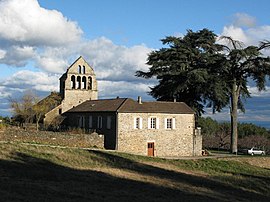Saint-André-Lachamp
Nowadays, Saint-André-Lachamp has become a topic of great relevance and interest in today's society. Since its emergence, Saint-André-Lachamp has sparked debates, controversies and reflections in different areas and sectors. Its impact is not only limited to the social aspect, but has also generated repercussions on a political, economic and cultural level. In this article, we will explore the various facets and dimensions of Saint-André-Lachamp, analyzing its evolution over time and its influence on our current reality. By delving into its different aspects, we will try to comprehensively understand its significance and the role it plays in modern society.
You can help expand this article with text translated from the corresponding article in French. (December 2008) Click for important translation instructions.
|
Saint-André-Lachamp | |
|---|---|
 The church in Saint-André-Lachamp | |
| Coordinates: 44°30′21″N 4°09′51″E / 44.5058°N 4.1642°E | |
| Country | France |
| Region | Auvergne-Rhône-Alpes |
| Department | Ardèche |
| Arrondissement | Largentière |
| Canton | Les Cévennes ardéchoises |
| Intercommunality | Pays Beaume Drobie |
| Government | |
| • Mayor (2020–2026) | Luc Parmentier[1] |
Area 1 | 17.09 km2 (6.60 sq mi) |
| Population (2022)[2] | 166 |
| • Density | 9.7/km2 (25/sq mi) |
| Time zone | UTC+01:00 (CET) |
| • Summer (DST) | UTC+02:00 (CEST) |
| INSEE/Postal code | 07213 /07230 |
| Elevation | 220–882 m (722–2,894 ft) (avg. 750 m or 2,460 ft) |
| 1 French Land Register data, which excludes lakes, ponds, glaciers > 1 km2 (0.386 sq mi or 247 acres) and river estuaries. | |
Saint-André-Lachamp (French pronunciation: [sɛ̃.t‿ɑ̃dʁe laʃɑ̃]; Occitan: Sant Andrieu de la Chalm) is a commune in the Ardèche department in southern France.
Population
| Year | Pop. | ±% p.a. |
|---|---|---|
| 1968 | 171 | — |
| 1975 | 150 | −1.85% |
| 1982 | 148 | −0.19% |
| 1990 | 157 | +0.74% |
| 1999 | 122 | −2.76% |
| 2007 | 120 | −0.21% |
| 2012 | 147 | +4.14% |
| 2017 | 154 | +0.93% |
| Source: INSEE[3] | ||
See also
References
- ^ "Répertoire national des élus: les maires". data.gouv.fr, Plateforme ouverte des données publiques françaises (in French). 9 August 2021.
- ^ "Populations de référence 2022" (in French). The National Institute of Statistics and Economic Studies. 19 December 2024.
- ^ Population en historique depuis 1968, INSEE
Wikimedia Commons has media related to Saint-André-Lachamp.


